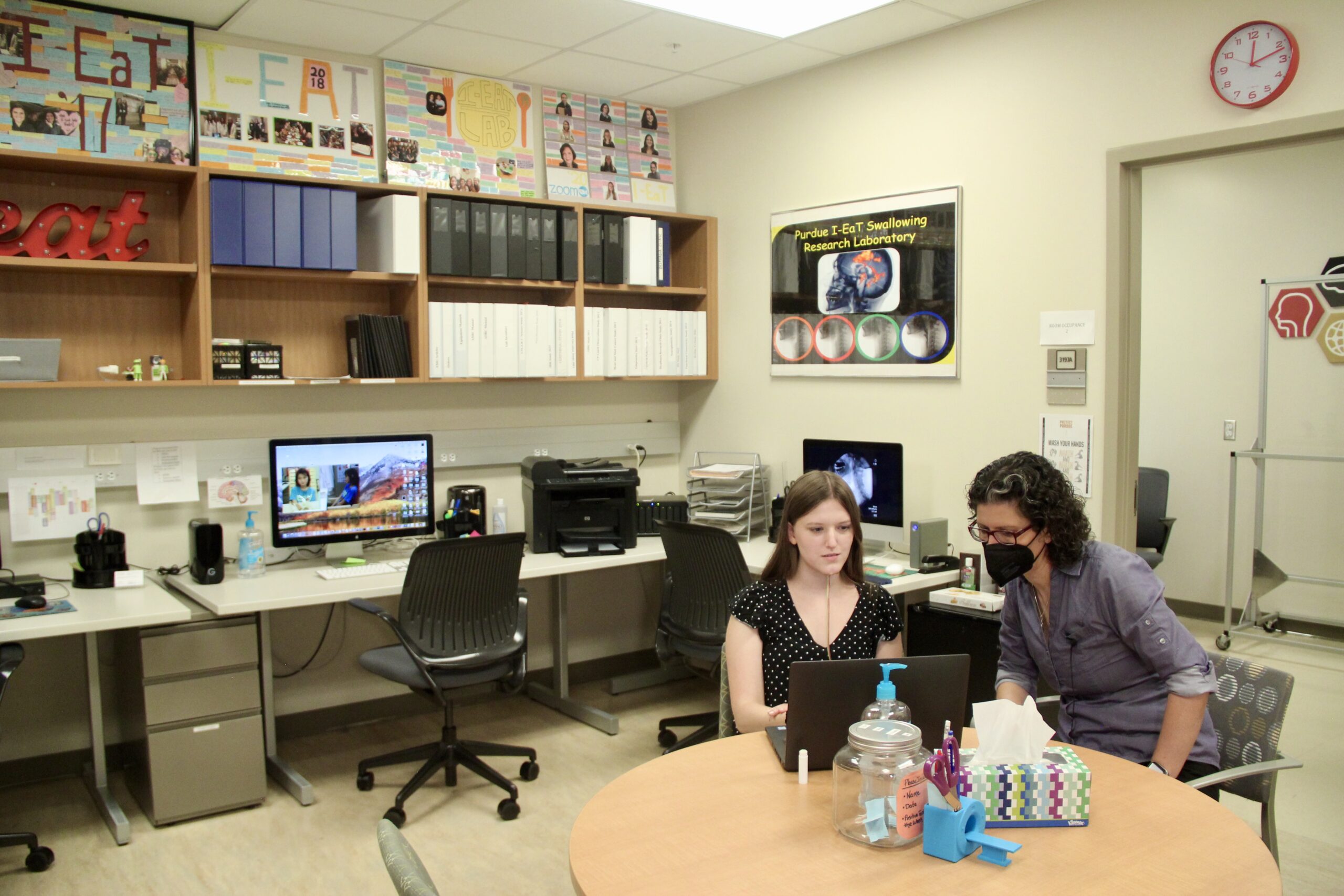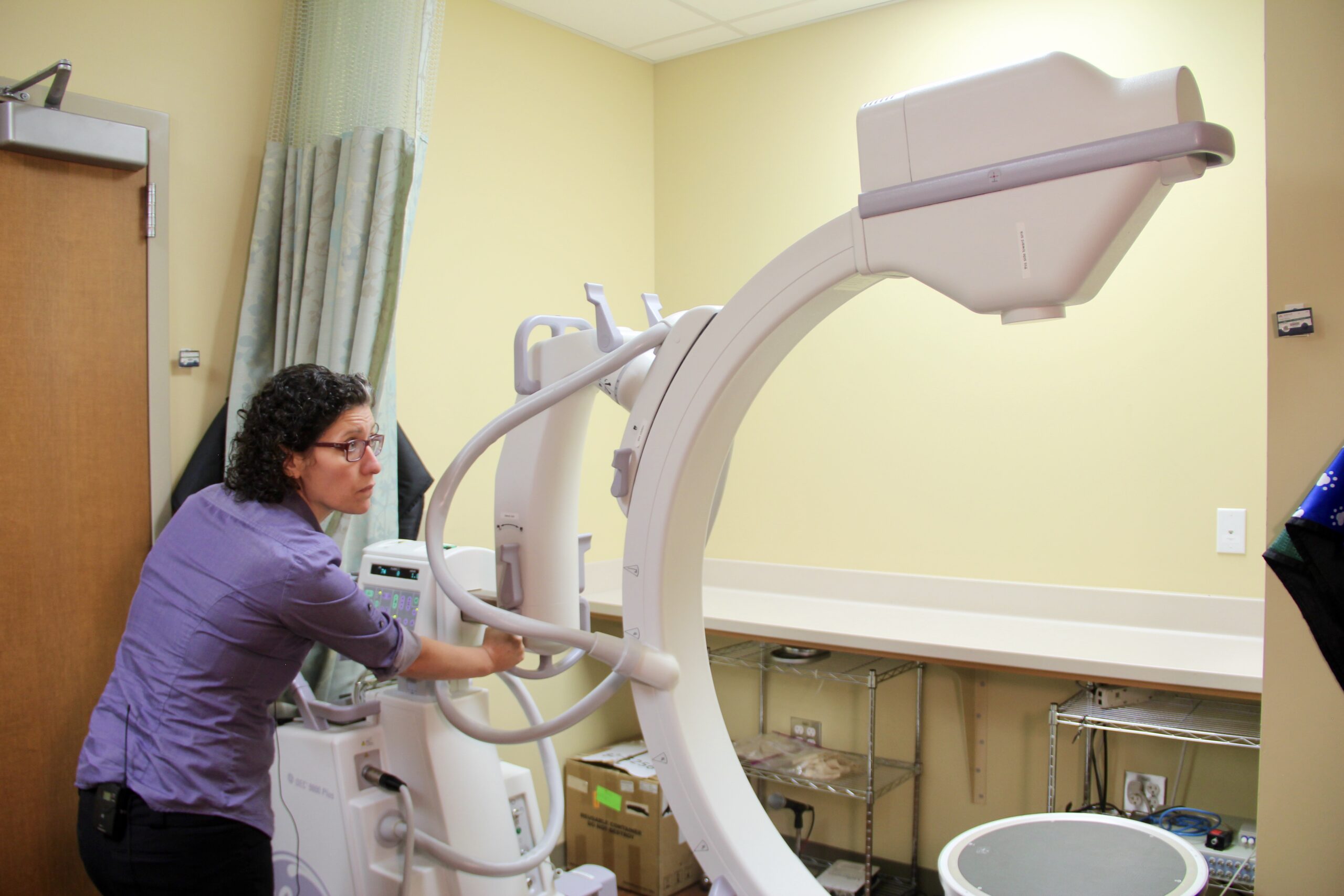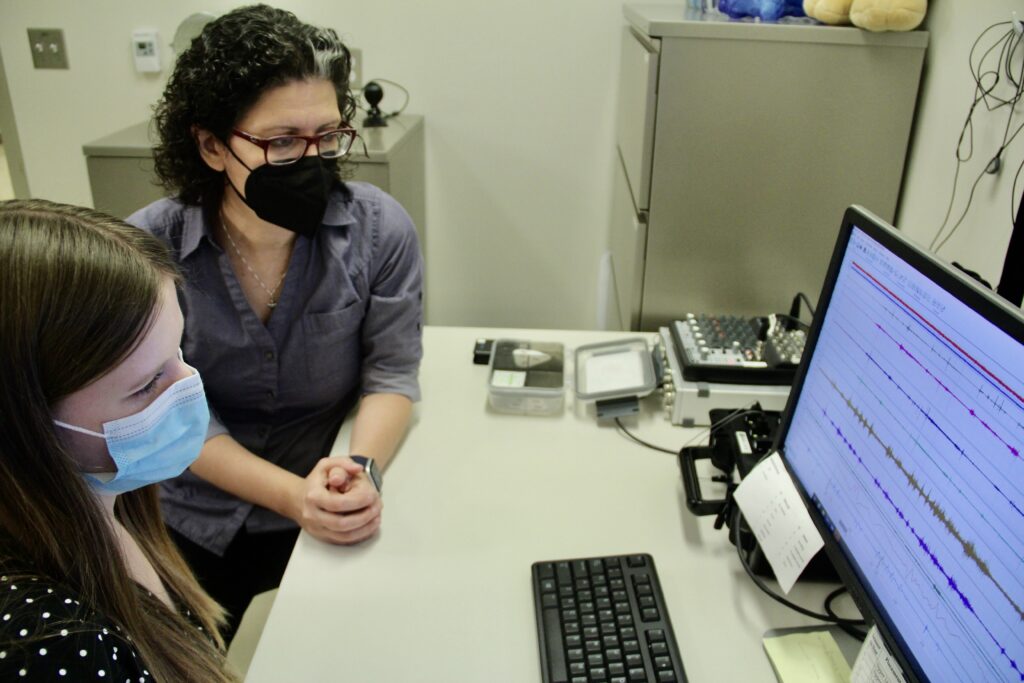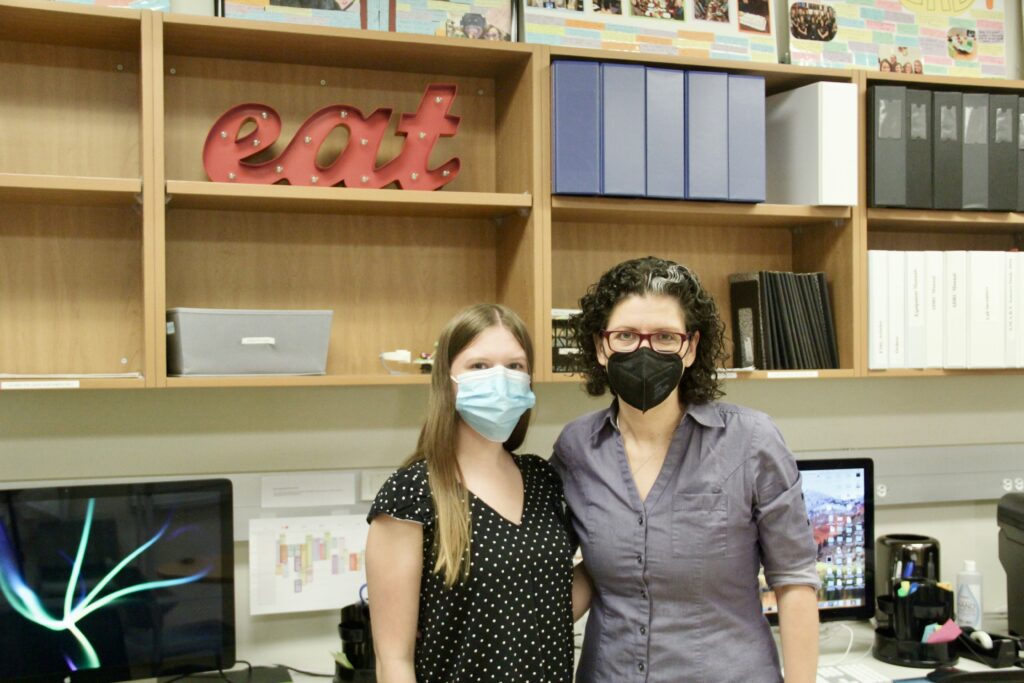Lab Culture: I-EaT Lab
By Tim Brouk, tbrouk@purdue.edu

Associate Professor Georgia Malandraki, right, works with graduate student Jennine Bryan in the I-EaT Lab.Tim Brouk
Millions of images of what we eat are posted to social media networks every day. Among its research initiatives, Purdue University’s Imaging, Evaluation, and Treatment (I-EaT) of Swallowing Research Lab studies images of how a person eats.
Georgia Malandraki, associate professor in the Department of Speech, Language, and Hearing Sciences, and her I-EaT Lab students take X-ray videos of participants eating food, measure how muscles in the mouth and neck react during swallowing using smart “muscle reader” electrodes, and take MRI images of people’s brains to see how their brains control this seemingly simple act.
“Swallowing is something we usually don’t think about,” Malandraki said. “But we swallow all the time. We swallow in our sleep. We swallow between 600 to 1,000 times a day, depending on how much we eat. But we don’t swallow only when we eat meals. We also swallow our saliva once every couple of minutes or else we would drool all the time.”
The striking x-ray videos of the food traveling down the participant’s mouth and throat are especially important in learning the physiological differences people suffering from dysphagia, or swallowing difficulty, have compared to those that can swallow with ease. Dysphagia can be brought on by conditions like stroke, cerebral palsy and Parkinson’s disease, among many others. Malandraki pays close attention to the brain and nervous system’s role in the act. Once thought to be an automatic function long ago, swallowing is now understood to be quite complex, and for one adult in every 25, it could be a critical health concern.
“What happens when a disruption, disease or disorder affects swallowing?” Malandraki said. “We use the information we learn from this more basic type of research to develop treatment protocols that are neurophysiology-based and hopefully will be more effective than symptomatic approaches that are currently more widely used.”
The efforts of Malandraki and her students also showcase the I-EaT Lab as a pioneering center for dysphagia telehealth, especially since the height of the COVID-19 pandemic. Patients are connected with the lab and clinic online and utilize supplies shipped to them for testing. Adults and children suffering from swallowing disorders can add to the research from home easier than ever.
“We treat and do research on patients across the life span,” Malandraki said. “And our aim is to find or develop evidence-based and reliable ways that clinicians can use to provide services to as many patients as possible, irrespective of geographical locations, ambulatory or socioeconomic status.”
Crucial tech

Malandraki adjusts a C-arm videofluoroscopy unit, which takes real-time x-ray videos of patients’ swallows.Tim Brouk
The I-EAT Lab has access to a C-arm videofluoroscopy unit to take real-time x-ray videos of the patients’ swallows. Shaped like a giant C, the machine’s camera reveals the swallow physiology process in remarkable detail. Students and the patients can witness the material being swallowed as well as the movements of important structures during the swallow. This system is a major compliment to I-EaT lab’s endoscopic, electromyographic and MRI imaging capabilities. These techniques allow investigators to comprehensively study all levels of swallowing control, from behavior, kinematics and muscle involvement all the way to the brain.
“To my knowledge, we are one of the very few swallowing research labs in the country outside of a hospital setting that has the capability to use all these types of equipment to evaluate and study swallowing function,” Malandraki said. “It’s really making our department and our University pretty unique in how comprehensively we can look at somebody’s swallowing.”
I-EaT also gathers data through electromyography, the recording of the electrical activity of muscle tissue. Malandraki and her students use various sensors that attach to patients’ faces and necks to gather this data. The Purdue researchers will soon publish work on a new wearable sensor they’ve developed for home use and the corresponding computer software. The new technology will provide feedback to patients during swallowing exercises.
“We are now starting to test this new sensor in clinical trials,” said Malandraki, adding that this work was made possible by a recent grant from the Center on Aging and the Life Course. “We will be sending the system home with patients, and we will be comparing its effectiveness against more standard, traditional methods of swallowing therapy.”
Kindness is key
After the images and the X-ray videos of people eating and swallowing, a visitor to the I-EaT lab will notice colorful posterboards prominently displayed. Each contains a year, pictures of past students and dozens of memories shared on paper. The tradition started with her 2016 student staff with the arrival of the Happy Thoughts Jar, which rests on a table near the lab’s entrance.
“We’re all encouraged once a week at least to put in a happy thought about the work in the lab, the environment in the lab or something personal we would want to remember,” Malandraki said. “We even did an online Happy Thoughts Jar during COVID to keep it going.”
At the end of the year, I-EaT students and staff gather to read the thoughts before they are displayed on the wall.
“I think it’s one of the most important moments in the lab,” Malandraki said. “One day, hopefully, I can fill the entire lab with posters, so I can remember and cherish all the happy moments we’ve had with students through the years.”
Kindness is paramount in her lab, according to Malandraki, because students interact with experiment participants and patients regularly, which often requires empathy, understanding and sympathy.
‘Friends and colleagues’

Bryan and Malandraki analyze data in the I-EaT Lab. 
Bryan started in I-EaT lab as an undergraduate researcher and has seen projects grow from ideas to clinical use.
The kindness overflowed into some student-driven I-EaT surprises. In recent years, students started the tradition of matching coffee cups with their names painted on them for those all-important caffeine breaks. Undergraduate students also designed COVID-19 protocol signage as well as paintings of I-EAT’s tryptic logo of a brain, globe, and a human’s profile outlining the mouth and throat.
Jennine Bryan has worked in the I-EaT Lab since 2018, first as an undergraduate researcher and now as a master’s student. She’s seen through projects from ideation to fruition. The life-changing research and comradery with Malandraki and her fellow students has her looking forward to more projects and eventually a career in a clinical setting.
“Having them as friends and colleagues has been really great,” Bryan said. “It’s been really great to see all of the projects progressing, and I’m seeing the work we’re doing research on actually in the clinic. It’s great to see that evidence-based practice really come to life.”
Discover more from News | College of Health and Human Sciences
Subscribe to get the latest posts to your email.